#meoto iwa
Explore tagged Tumblr posts
Text

Kawase Hasui - Futami Seashore (The Wedding Rocks of Futamigaura), color woodblock print, 1933.
2K notes
·
View notes
Text
Meoto Iwa - the married rocks of Futami
We noted the presence of "married camphor trees" at Meiji-jingû last time, so I guess we can talk about other sacred things linked by rope.

One of the most famous of these is the couple of "married rocks" on the coast of Mie, on the premises of Okitama-jinja at Futami, near Ise. The Meoto Iwa represent the founding couple of Japan according to Shinto, Izanagi and Izanami.

The shimenawa ropes are more heavy-duty than what we saw on the camphor trees: 5 strands, 40 kg each. Still, as they are exposed to the seawater spray from crashing waves, they need to be changed several times a year, which involves quite a few people as you'd expect, as shown on the poster below. Ceremonies occur in May, September and December.

The ropes certainly look heavy on the smaller rock in particular, they look like they could slip off, but instead they cling on rather gracefully.

Dotted around the shrine are statues of the messengers of the gods: frogs.

While Futami's Meoto Iwa is the most important example of "paired rocks" in Japan, owing to how far the tradition dates back and its proximity to Ise Grand Shrine, there are quite a few others across the country. Below is another Meoto Iwa in Mihonoseki, Shimane.

#Japan#Mie-ken#Ise#Futami#Okitama-jinja#Shimane-ken#Mihonoseki#Meoto Iwa#married rocks#shimenawa#三重県#伊勢#二見#興玉神社#島根県#美保関#夫婦岩#2018-04
157 notes
·
View notes
Text

"Futamigaura" by Kobayashi Kiyochika (小林清親), 1896, featuring of course the Meoto Iwa (夫婦岩) wedded stones of Futami Okitama Jinja Shrine (二見興玉神社) in Mie Prefecture
"Futamigaura" de Kobayashi Kiyochika (小林清親), 1896, que presenta por supuesto las piedras casadas (es decir, los Meoto Iwa (夫婦岩)) del santuario Futami Okitama Jinja (二見興玉神社) en la prefectura de Mie
#japanese art#arte japonés#小林清親#kobayashi kiyochika#三重県#mie prefecture#二見浦#futamiura#夫婦岩#meoto iwa#二見興玉神社#futami okitama jinja#japanese prints#impresiones japonesas
97 notes
·
View notes
Text

What’s the Meaning Behind this Japanese Rock Sculpture?
The Shinto shrine that acts like a modern installation piece
Meoto Iwa (夫婦岩), or the Married Couple Rocks, in the sea off Futami, Mie, Japan.
The Married Couple Rocks are two small rocky stacks in the sea just off the Japanese coastline. Between the two rocks a thick rope is hung, representing the concord of marriage.
Image source Wikimedia Commons

#wikimedia commons#photographer#meoto iwa#shinto shrine#shrine#married couple rocks#japan#futami#mei#concord of marriage#travel
3 notes
·
View notes
Text
Stones
As in other cultural traditions, some of the oldest Shinto artifacts remaining in use for religious purposes are stones, some dating back probably 3,000 years. In Shinto, a stone that radiates great beauty, dignity, and elegance and that commands the worshipers’ spirits may be adorned with a sacred rope and revered. Stones and rocks used in Japanese gardens often make observers catch their breath. The manner in which they are placed to show their natural beauty at its best, surrounded only by gravel, has long been a device used to stimulate the imagination to contemplate the eternal and the mysterious. However, it is in their natural environmental setting that the power of great stones is best seen.


(The above photos are mine please do not use without asking)
Excerpts from A Litany of the Stone
...Stones speak to us of endurance, strength, power, and mass
Focus upon the image of a stone that speaks to you of the divine
The flow of life carries away those things that we neither need nor want...
...Look at a great stone and ponder its strength and majesty
A home for birds
A shade in the heat
A landmark to the lost
Let us learn from the great stones
Let the identity that endures change and transition give confidence to our changing...
5 notes
·
View notes
Text

Spent a bit too much time today, thinking about sacred stones.
#gintama#sakata gintoki#my mind has been on ise lately#and the meoto iwa there#and i wondered if the place gintoki visited was a real place#but it's probably not. right?#episode 365: salvation
14 notes
·
View notes
Text

Meoto Iwa (Wedded Rocks) off the coast of Ise, Mie Prefecture, Honshu, Japan
7 notes
·
View notes
Text
This is not my usual tumblr nonsense, but I was talking to someone on the ferry back to Aomori about places in Japan that I particularly love. So in case any of you are planning a trip, in no particular order, these are my current top 5 places in Japan.
Ise, Mie Prefecture (location of the Ise Grand Shrine, the most sacred Shinto site. Visit the outer and inner shrines, check out the Meoto Iwa/married rocks, eat udon and mochi, and buy some pearls.)
Iya Valley, Tokushima Prefecture (one of the most remote places in Japan. Take a river cruise through the Oboke Gorge, visit a historic village, walk across one of the vine bridges, and eat soba. Caveat: best experienced with a car.)
Yamagata, Yamagata Prefecture (walk up the 1,000 steps to Yama-Dera, relax at Ginzan Onsen or Zao Onsen, go to the Three Mountains of Dewa, eat beef and cherries, if they're in season. If it's winter and this is your thing: ski.)
Matsumoto, Nagano Prefecture (visit Matsumoto Castle, which is original not a reconstruction, go to the art museum and the ukiyo-e museum, check out the historic shopping streets, cafe hop, eat oyaki and soba.)
Hakodate, Hokkaido Prefecture (see the view from Mt. Hakodate, check out Motomachi, the old European quarter, walk around Goryokaku Park, eat seafood at the morning market, and don't skip the milk flavor ice cream. Hokkaido is famous for dairy.)
You may have noticed that there are food recommendations attached to all of them. Everywhere in Japan has at least one local speciality that you are contractually obligated to eat. I don't make the rules.
10 notes
·
View notes
Text

Koho Shoda - The Married Rocks (of Futamigaura), color woodblok print, c. 1910.
271 notes
·
View notes
Text

Meoto Iwa (Wedded rock) next to the Futamiokitama Shrine in Ise
37 notes
·
View notes
Text
Japan's biggest shimenawa: Izumo Taisha Kagura-den

We've seen larger and larger sacred ropes in our previous posts, and here's the largest of all: the shimenawa adorning the Kagura-den at Izumo Taisha. It is 13.5 m long and weighs 5 tons!

Shimenawa ropes are made with hemp or rice straw. This shot shows just how densely packed Izumo Taisha's shimenawa is - it's almost like a tree trunk, truly an impressive and imposing feature.
Here and in previous examples, we can see folded paper shide streamers, another symbol of sacred items in Shinto, on the first picture. Knots also appear, particularly on the ropes on the Meoto Iwa at Futami, as paper would not fare well by the sea... These ropes and streamers indicate a demarcation line between our world and the realm of kami spirits.

The Kagura-den is a hall just outside the main compound of Izumo Taisha, to the West. It was built to house kagura rituals, traditional dances which retell the stories of the early gods. As Izumo, formerly in Iwami province, is one of the most ancient shrines in Japan, Iwami Kagura is one of the major forms of the dance.
As a bonus, here's a train decorated with characters of Iwami Kagura.

#Japan#Shimane-ken#Izumo Taisha#Shinto#shimenawa#kagura#Iwami Kagura#train#JR West#KiHa 126#島根県#出雲大社#注連縄#神楽#石見神楽#2023-07
11 notes
·
View notes
Text

The sacred Meoto Iwa (夫婦岩) or Husband & Wife Rocks off the coast of Ise, Mie Prefecture
Photo by the Asahi Shimbun
Image from "Shintō: The Sacred Art of Ancient Japan" edited by Victor Harris, published by the British Museum Press. 2001, page 16
69 notes
·
View notes
Text
🇯🇵⛩️Japan day 9 - last day of the road trip
Today we visited Ise, birthplace of Shintoism and home of Japan's most important shrine to Amaterasu-Omikami, the sun goddess who gave birth to the Imperial line.
⛩️Ise-Jingu is an immense shrine spanning the entire region, and containing 125 small shrines. The most important one is Naiku, the one where Amaterasu-Omikami is enshrined. Historically the high priests and priestesses of the shrine belonged to the imperial line, and the current high priestess is the daughter of retired emperor Akihito. The entire shrine (like, the main buildings, torii, etc, the whole shebang) is rebuilt anew every twenty years; the operation takes nine years and involves hundreds of rituals.
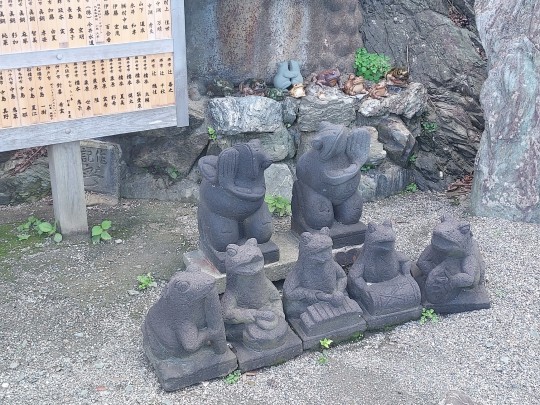
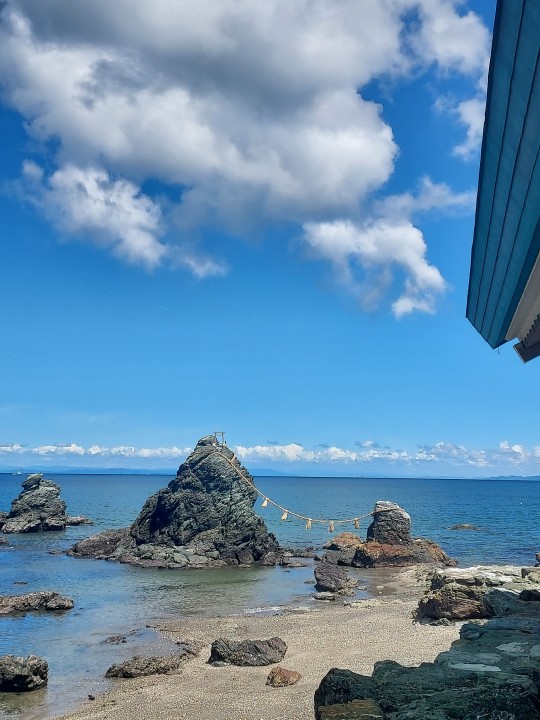
Ise shrine has been an important place of pilgrimage since the Edo era. The traditional route is to first purify yourself at Futamiokitama shrine, home of the famous Meoto Iwa "married stones", where young women pray for an auspicious marriage. The rocks represent Izanagi and Izanami, the original gods and parents of Amaterasu & co. The enshrined kami, Sarutahiko Okami, has frogs for their messenger animal, and there are frog statues and frog-decorated merch to buy. I nearly bought a tadpole-shaped omamori (might go back tomorrow for it).
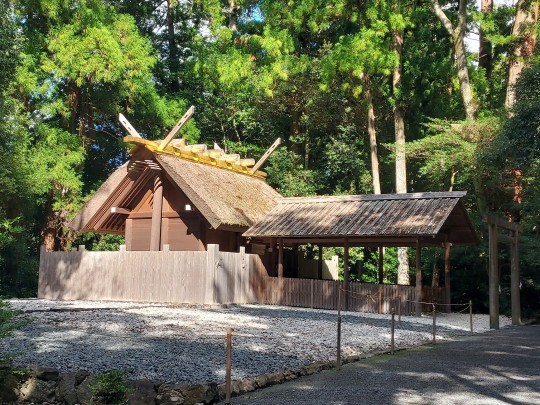
Then you visit Geku shrine, dedicated to Toyouke Ohime. She is the goddess of food, clothes and homes. She was summoned and enshrined in Ise after an emperor had a vision of Amaterasu basically saying "I love it here but there's no food, bring my pal over so she can cook for me".
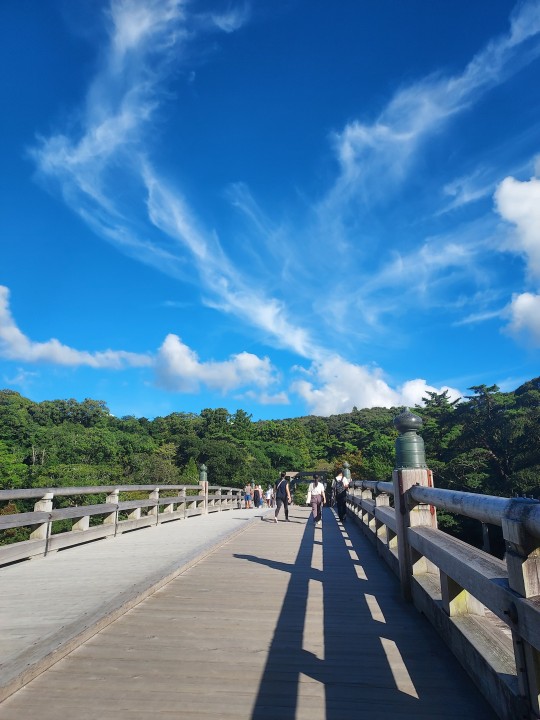
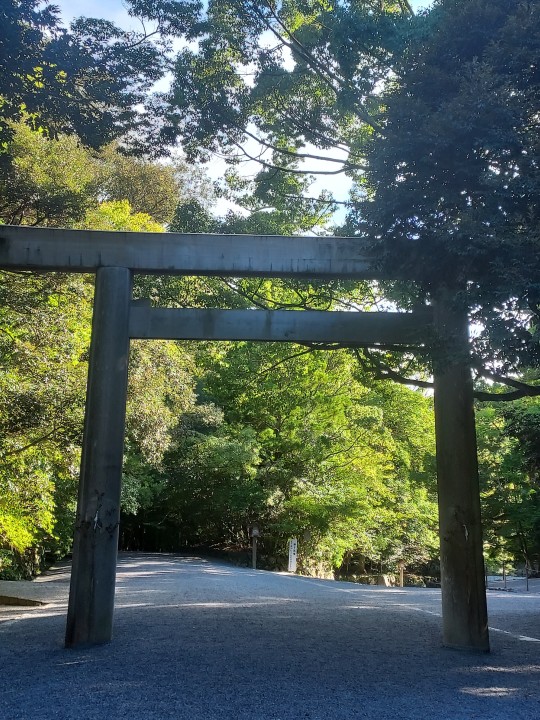
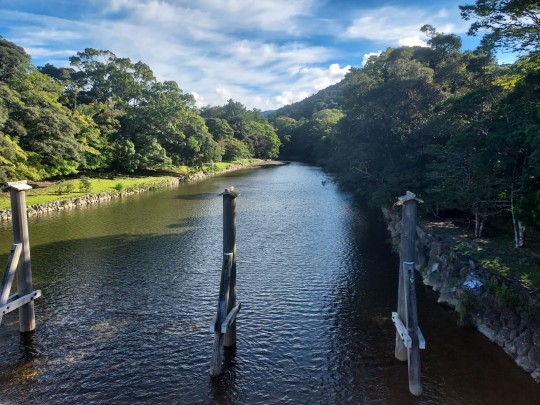
And lastly, you visit Naiku shrine, home of Amaterasu the sun goddess, protector of Japan. You can even ourify yourself djrectmy in the river rather than in a temizuya.
The shrines themselves were a little underwhelming, especially when compared with the other shrines I've seen so far. All of the buildings were made of plain wood, which is logical when you account for the fact that they're rebuilt every 20 years. You also cant see the atars, which are hidden behind walls or cloths, and there are no statues.
On the other hand, plain wooden buildings shaped like rice granaries in the middle of a forest /does/ bring you closer to nature, which is the origin of shintoism (which is at heart an animist belief). All in all, it was a important place to cross off the bucket list.
Also, tonight I can sleep on a real mattress for the first time in 10 days 🥳 And tomorrow we head back to Tokyo.
14 notes
·
View notes
Text
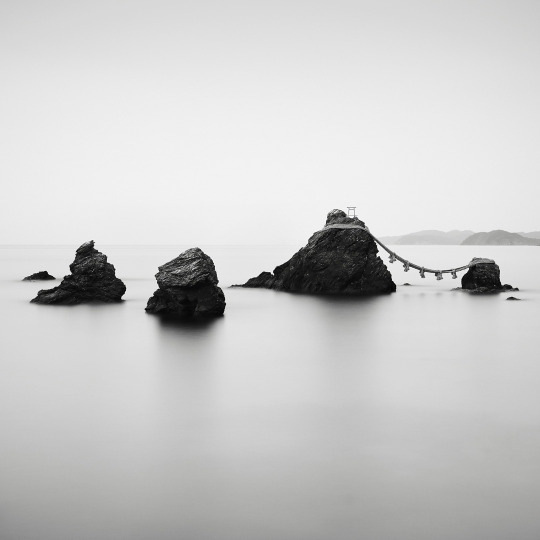
Japan #24 - Meoto Iwa Study II by Stefano Orazzini https://www.artlimited.net/7787/art/photography-japan-24-meoto-iwa-study-ii-digital-nature-landscape-waterscape-lake-river/en/249598
4 notes
·
View notes
Text
Did you know that the Japan archipelago was created by Izanagi and his sister Izanami? But they were not the first Kami (deities) to come into existence. Read all about the Myth of the Creation of Heaven and Earth here!
#japanese#japan#mythology#history#japanese mythology#japanese history#kami#izanagi#izanami#myth#blog
2 notes
·
View notes
